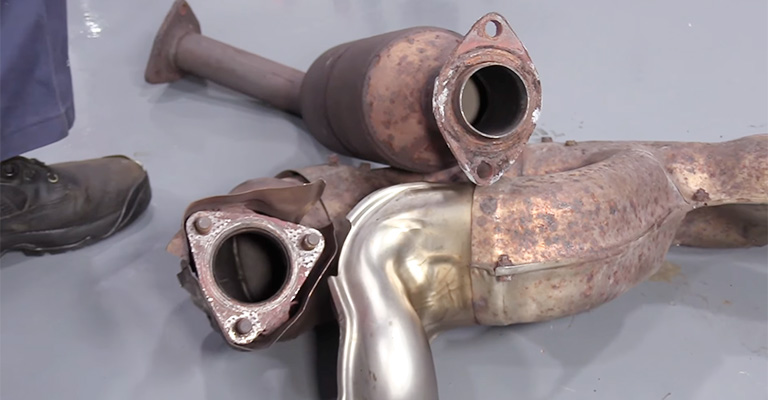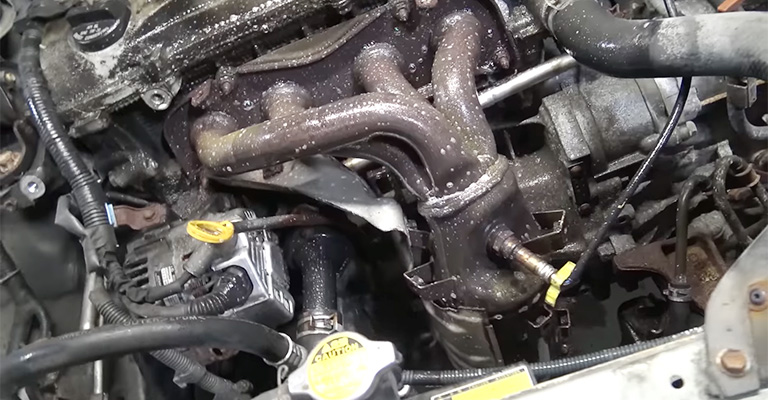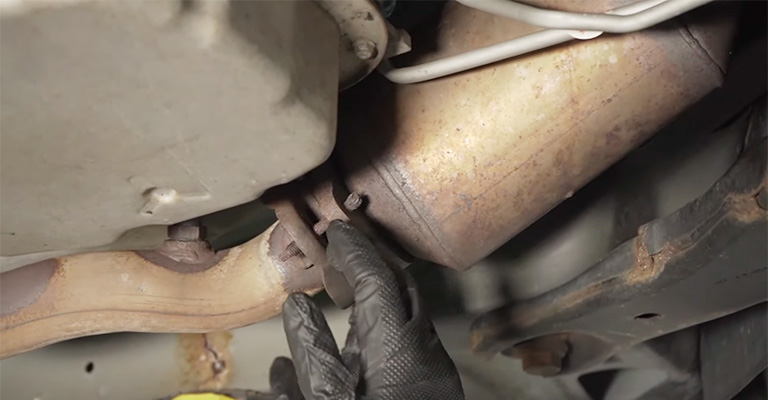The catalyst system plays a vital role in ensuring vehicle emissions control, reducing harmful pollutants that are released into the environment. It consists of various components working together to minimize the impact of vehicle emissions on air quality.
One crucial component of this system is the catalytic converter. The catalytic converter, found in the exhaust system, acts as a catalyst to facilitate chemical reactions that convert harmful gases into less harmful substances.
It contains precious metals such as platinum, palladium, and rhodium, which promote these reactions.
By transforming pollutants like carbon monoxide, nitrogen oxides, and unburned hydrocarbons into carbon dioxide, nitrogen, and water vapor, the catalytic converter helps to mitigate the environmental impact of vehicle exhaust.
However, the catalyst system’s efficiency can sometimes fall below a specified threshold, triggering diagnostic trouble codes (DTCs) in the vehicle’s onboard computer system.
When this happens, it indicates that the catalytic converter may not be functioning optimally, and further investigation is required.
Several factors can contribute to catalyst system efficiency below threshold codes. While a failed catalytic converter is one potential cause, it is important to note that catalytic converters themselves rarely fail on their own.
In Honda vehicles, other factors may also contribute to this issue, including faulty sensors, circuit problems, exhaust leaks, or outdated software in the engine control module (ECM).
Honda vehicles have their unique characteristics when it comes to the catalyst system. Honda has been at the forefront of technological advancements and environmentally friendly innovations in their vehicles.
They have implemented efficient catalytic converter designs and integrated advanced sensor systems to monitor the catalyst system’s performance accurately.
Understanding the catalyst system’s importance in emissions control and recognizing the common causes of catalyst system efficiency below threshold codes in Honda vehicles will empower Honda owners to take appropriate actions when faced with such issues.
By addressing these problems promptly and effectively, Honda owners can ensure their vehicles continue to operate efficiently and minimize their environmental impact.

Understanding the Catalyst System
The catalyst system, comprised of various components, plays a critical role in reducing harmful emissions produced by vehicles. Central to this system is the catalytic converter, which serves as a key component in the emissions control process.
The catalytic converter is responsible for facilitating chemical reactions that convert harmful gases into less harmful substances. Inside the converter, precious metals such as platinum, palladium, and rhodium act as catalysts, promoting the conversion of toxic pollutants.
Carbon monoxide (CO) is transformed into carbon dioxide (CO2), nitrogen oxides (NOx) are converted into nitrogen (N2), and unburned hydrocarbons (HC) are oxidized into carbon dioxide and water vapor (H2O).
Maintaining optimal catalyst system efficiency is crucial for environmental compliance. By effectively reducing harmful emissions, the catalyst system helps to improve air quality and minimize the impact of vehicle exhaust on the environment.
It contributes to meeting regulatory standards for emissions set by government agencies, promoting a cleaner and healthier environment for all.
Several components work together to ensure the catalyst system’s efficiency and performance
Oxygen Sensors
Oxygen sensors, located in the exhaust system, monitor the amount of oxygen present in the exhaust gases.
They provide feedback to the engine control module (ECM) about the air-to-fuel ratio, allowing the ECM to make adjustments for optimal combustion and efficient operation of the catalyst system.
Malfunctioning or faulty oxygen sensors can lead to inaccurate readings and affect the catalyst system’s efficiency.
Exhaust Leaks
Any leaks in the exhaust system can introduce additional oxygen into the system, disrupting the proper functioning of the catalytic converter.
Excess oxygen can hinder the catalytic reactions, leading to reduced efficiency and triggering catalyst system efficiency below threshold codes.
Identifying and repairing exhaust leaks is essential for maintaining optimal catalyst system performance.
Engine Control Module (ECM)
The ECM, also known as the engine control unit (ECU), is responsible for monitoring and controlling various aspects of the vehicle’s operation. It receives input from sensors, including oxygen sensors, and makes adjustments to optimize engine performance and emissions control.
Outdated software in the ECM can lead to incorrect readings and affect the catalyst system’s efficiency. Keeping the ECM software up to date is crucial for accurate monitoring and control of the catalyst system.
By understanding the role of the catalytic converter, recognizing the importance of maintaining optimal catalyst system efficiency for environmental compliance, and being aware of the components involved (oxygen sensors, exhaust leaks, and the ECM).
Honda owners can effectively address catalyst system efficiency below threshold codes and ensure their vehicles operate in an environmentally responsible manner.
Symptoms of Catalyst System Efficiency Below Threshold

When the catalyst system efficiency falls below the designated threshold, certain symptoms may manifest in Honda vehicles. Recognizing these signs can help vehicle owners take timely action and address the underlying issues.
Here are two common symptoms to be aware of.
Illumination of the Check Engine Light
One of the primary indicators of catalyst system efficiency below threshold is the illumination of the check engine light on the vehicle’s dashboard.
When the ECM detects an issue with the catalyst system, it generates a diagnostic trouble code (DTC) and activates the check engine light.
It serves as a warning signal for drivers to seek professional assistance and diagnose the specific problem causing the efficiency drop.
It’s important not to ignore the check engine light, as continued driving without addressing the issue can lead to further damage and potentially more expensive repairs.
Performance Issues
Reduced power or fuel efficiency can be noticeable symptoms of catalyst system efficiency below threshold. When the catalytic converter or other components within the system are not functioning optimally, it can impact the overall performance of the vehicle.
Drivers may experience a decrease in engine power, sluggish acceleration, or a noticeable decrease in fuel efficiency. These performance issues can arise due to disrupted exhaust flow or compromised combustion processes resulting from an inefficient catalyst system.
It’s worth noting that while these symptoms can be indicative of catalyst system efficiency below threshold, they can also overlap with other vehicle issues.
Therefore, it is crucial to have a proper diagnosis performed by a qualified technician or authorized Honda service center to accurately identify the root cause of the problem.
By paying attention to warning signs such as the illumination of the check engine light and observing possible performance issues like reduced power or fuel efficiency, Honda vehicle owners can take proactive steps in addressing catalyst system efficiency below threshold.
Seeking professional assistance and diagnosis will help resolve the underlying issues promptly and ensure the vehicle continues to perform optimally while minimizing its environmental impact.
Common Causes of Catalyst System Efficiency Below Threshold Codes in Honda

Failed catalytic converter
The catalytic converter is often the primary cause of catalyst system efficiency below threshold codes. While it rarely fails on its own, it can be affected by other issues such as contaminated fuel, engine misfires, or excessive oil consumption.
Over time, the precious metals within the catalytic converter can degrade or become coated with deposits, hindering their ability to facilitate the necessary chemical reactions for emissions reduction.
Faulty sensors
Oxygen sensors play a crucial role in monitoring the catalytic converter’s performance. They measure the oxygen content in the exhaust gases and provide feedback to the ECM for optimal air-to-fuel ratio control.
Faulty oxygen sensors can provide inaccurate readings, leading to incorrect adjustments by the ECM and subsequently affecting the catalyst system’s efficiency.
Replacement of malfunctioning sensors is necessary to restore proper monitoring and control.
Circuit problems
Damaged wiring or poor connections within the catalyst system can have a significant impact on its effectiveness. Faulty wiring or loose connections can disrupt the communication between the sensors, ECM, and catalytic converter.
This can result in inaccurate readings and compromised system performance. Thorough inspection and repair of any circuit issues are vital for restoring proper functionality.
Exhaust leaks
Exhaust leaks can introduce additional oxygen into the system, affecting the catalytic converter’s ability to perform optimally. The excess oxygen can cause false readings and trigger efficiency below threshold codes.
These leaks can occur at various points within the exhaust system, such as gaskets, flanges, or cracks in the piping. Identifying and repairing exhaust leaks is essential to maintain the integrity of the catalyst system.
Outdated software
The ECM software plays a critical role in monitoring and controlling the catalyst system. Outdated software can lead to incorrect readings and false codes.
It is important to keep the ECM software up to date to ensure accurate monitoring and control of the system.
Regular software updates, performed by authorized Honda service centers or qualified mechanics, can help prevent false codes and ensure optimal performance.
Diagnosing and Resolving the Issue
Proper diagnosis is essential to pinpoint the specific cause of catalyst system efficiency below threshold codes. It is recommended to seek professional assistance from an authorized Honda service center or an experienced mechanic.
They have access to diagnostic tools and specialized knowledge to accurately identify the underlying issues.
A thorough inspection of the catalyst system, sensors, wiring, and exhaust system is necessary to identify any faults or malfunctions.
This may involve conducting tests on the catalytic converter, inspecting the oxygen sensors for proper functioning, checking the integrity of the wiring and connections, and examining the exhaust system for leaks or damage.
Based on the diagnosis, appropriate repairs or replacements can be carried out. This may include replacing a failed catalytic converter, repairing or replacing faulty sensors, addressing circuit problems, fixing exhaust leaks, or updating the ECM software.
By relying on professional diagnosis and visiting authorized Honda service centers or experienced mechanics, Honda owners can ensure accurate troubleshooting and effective resolution of catalyst system efficiency below threshold codes.
Thorough inspection and appropriate repairs or replacements will restore the catalyst system’s efficiency and ensure the vehicle meets emissions standards while operating optimally.
Preventive Maintenance and Care
Maintaining optimal catalyst system efficiency in Honda vehicles is crucial for their overall performance and environmental compliance.
By following these tips and adopting a proactive approach, Honda owners can prevent potential issues and ensure the longevity of their catalyst systems.
Use High-Quality Fuel
Using high-quality fuel can help maintain the cleanliness of the catalytic converter. Low-quality or contaminated fuel can lead to the accumulation of deposits on the precious metals within the converter, affecting its efficiency over time.
Opting for reputable fuel stations and avoiding fuel with a high sulfur content can help preserve the catalyst system’s effectiveness.
Adhere to Regular Maintenance Schedules
Follow the recommended maintenance schedule provided by Honda for your specific model.
Regular maintenance tasks, such as oil changes, air filter replacements, and spark plug inspections, contribute to the overall health of the engine and indirectly impact the catalyst system’s performance.
Properly maintained engines are less likely to experience issues that can negatively affect the catalyst system.
Address Check Engine Lights Promptly
If the check engine light illuminates, it is essential to address the issue promptly. The check engine light serves as an early warning system, indicating a potential problem in the vehicle, including the catalyst system.
Ignoring the light can lead to further damage or more costly repairs. Seek professional assistance and diagnostic services from authorized Honda service centers or experienced mechanics to identify and resolve the underlying issue causing the efficiency below threshold codes.
Periodic Emission System Checks
Periodically performing emission system checks can help identify potential issues before they become significant problems. Some Honda vehicles are equipped with onboard diagnostics that allow for self-checks of the emissions system.
Additionally, authorized Honda service centers or qualified mechanics can conduct comprehensive emission system inspections.
These checks can help detect early signs of catalyst system inefficiency or other related problems, allowing for timely intervention and necessary repairs.
By implementing these preventive maintenance measures and promptly addressing any issues that arise, Honda owners can optimize their catalyst system’s efficiency.
Regular maintenance, the use of high-quality fuel, prompt response to check engine lights, and periodic emission system checks contribute to a well-functioning catalyst system and ensure compliance with emissions standards.
Ultimately, these practices help extend the lifespan of the catalyst system and promote a cleaner and healthier environment.
Conclusion
Maintaining optimal catalyst system efficiency in Honda vehicles is crucial for environmental compliance, vehicle performance, and overall longevity.
The catalytic converter plays a vital role in reducing harmful emissions, and understanding its importance is key.
Common causes of catalyst system efficiency below threshold codes include failed catalytic converters, faulty sensors, circuit problems, exhaust leaks, and outdated software.
Promptly addressing symptoms such as the check engine light and performance issues is essential to prevent further damage.
Seeking professional diagnosis and visiting authorized Honda service centers or experienced mechanics is recommended for accurate troubleshooting.
Implementing preventive maintenance measures like using high-quality fuel, adhering to regular maintenance schedules, addressing check engine lights promptly, and conducting periodic emission system checks helps maintain optimal efficiency.
By following these practices, Honda owners can ensure their vehicles operate efficiently, minimize environmental impact, and extend the lifespan of their catalyst systems.

Leave a Reply